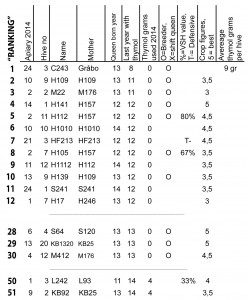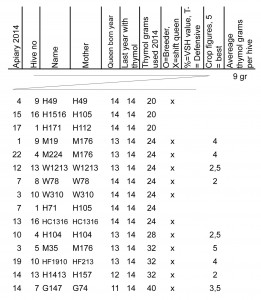Around Christmas I get time to do work on an Excel application on the computer, feeding it with new figures about the honeybee colonies from the season. It helps me identify the least good colonies (which will get their queens shifted coming season) and the best ones, which to breed from.
I focus on Varroa resistance, good honey crop, easy management, low defensiveness, low swarming tendency and keeping track of the motherline, so I can trace the heritage somewhat. Earlier, when I got the virgins mated on isolated mating places with drones from sisterqueen, I had nice pedigrees. Now when there are only Elgon bees (or almost) where the virgins mate I just make a note of the apiary where they got mated.
Focus on traits
A. The evaluation of Varroa resistance is kind of a two-step stair:
- The Varroa population is allowed to grow until (or not) the colony shows one or more wingless bees, which I interpret as a sign of presence of Deformed Wing Virus (DWV). This virus is the most common in connection with Varroa. If so the colony gets one or two pieces of dishcloth with 4 grams of Thymol each. One piece usually if the colony is weaker, for example in spring (or a strong colony late in season that probably didn’t need it – just in case). If still DWV-bees 7-10 days later another piece(s), etc. This is done regardless if there are honey supers on the colony. But if harvest time is a week later I wait until then. Most Thymol is though given either before (in spring) or after nectar flow (late summer). Thymol goes mostly into wax and wooden parts and gets ventilated away again. Honey has never got any taste of thymol with me.
- When the breeder candidates have been identified – those that have been without thymol the longest and still have a honeycrop higher than average – I test those for VSH the coming season, if they have wintered and develop well. In 2014 I tested the breeders after I had used them due to lack of time. I want to do this in May before I choose which to graft from.
B. The honey crop is compared between all relevant bee colonies. This is done with the help of a ranking list with estimated honey crops instead of the actual figures. That shouldn’t be correct due to different conditions in different apiaries/locations. This way it’s more correct even if it never will be exactly correct.
Consideration is taken to colony strength in spring (just after the main cleansing flight, late March/early April), crop size (including roughly how much honey is left with the bees), and if bees have been taken from the colony for making new colonies or mating nuces. Consideration is also taken to autumn strength after the season (in November after the old field bees have died). An average of the resulting theoretical honeycrops is calculated for each apiary for relevant colonies. Too weak colonies in spring or hives that have swarmed too much or is weakened too much of disease (virus from varroa mostly) are not included in the average. Then all averages for all apiaries are used to make an “selection average” for apiaries (for 2014 it was 91 kg – 200 lb). Then each apiary average is compared to this overall “selection average” and an adjustment is made, up or down for each apiary. Then a final calculated honey crop and a following grade is made for each colony and finally the ranking list.
Why I ended up with a 9-point scale (1–1.5–2–2.5–3–3.5–4–4.5–5) I don’t know. To be considered as a breeder I mostly want a colony to have at least 3.5 points, that is above average in honey production.
C. I almost never use a queen that has swarmed. There must be a very good reason for doing so, for example trying the queen of the wall – http://www.elgon.es/diary/?p=505 – http://www.elgon.es/diary/?p=515 . If a daughter queen is not shifted by me in the leftover colony, she has to show herself worthy coming seasons, just like every other colony.
D. I don’t want to use a defensive colony and very seldom do. I tried one in 2013. Actually one of her daughters is a breeder candidate for 2015, with good temper, but the average among her sisters is not good. But bad temper is actually one of the easiest traits to make better through selection.
Ranking list 2014
Let’s look at the ranking list for 2014. Most important is how many years the bees of a colony (and their relatives and ancestors in the same colony) have not got any Thymol. Sometimes in the history of the colony, a split may have been done early in the season before the mother colony got Thymol. This could have happened more than once. The best colonies come at the top of the ranking.
Thymol used in the previous season (2014) is zero grams for a colony considered as a breeder (2015). And this colony should not be a new colony of that year (2014), but a big colony that has wintered at least once with the present queen (maybe a new colony the year before, 2013) and produced a crop. 2014 is the first year I have colonies that havn’t tasted thymol for two years as big colonies (2013 and 2014).
 Click on the list to make it bigger and readable, then click on the back arrow in the upper left corner to get back to the text.
Click on the list to make it bigger and readable, then click on the back arrow in the upper left corner to get back to the text.
Among the top 11 on the ranking list, one is too defensive and 3 have queens born 2014. Two were breeders already in 2014. They may be good enough also for 2015 – H112 and H105.
Number 6 on the list is not considered for 2015, as the colony swarmed, but I keep an eye on it as it still produced a good crop. Maybe it can be considered for 2016. Number 7 has not a good temper and it’s queen is mated at the edge of the Elgon area with possible influence of non-Elgon heritage, but so what, if the traits are good, but temper is not in this case. But if I hadn’t had any other colonies… Number 9 is a split from H112 that made a queen of their own this year. Maybe a breeder 2016? Number 11 shifted its queen early in the season. Maybe a breeder 2016?
Number one on the list is the queen of the wall (see above). I have put the last year with thymol to 2008 for her, just to put a figure in the column. Probably those bees, well their ancestors, have never tasted any miticide at all. Now that colony may not be as resistant as the best of my other ones as they havn’t, living on their own, had any reinfestation, and they have got a brood cycle break every year (swarm) and have a smaller amount of brood due to a smaller nest than a big hive, so I will make just a few daughters. But they have to be hardy. Number 3 is considered as the bees (their ancestor bees and colony) tasted thymol as far back as 2011, though the crop grade is just average.
In 2014 the breeder colonies had been without thymol for one year (2013) as big colonies (and not two or more for the best considered for 2015). The best of such ones for 2015 are number 28, 29 and 30.
Now this season of 2014 I gave thymol when seeing just one single wingless bee outside a colony on the hardboard. Earlier seasons I waited till I saw at least two. And still earlier at least three. The threshold for giving thymol is getting lower to get a still better selection and a quicker improvement of the stock. It’s because of the improvement this lower threshold is possible. If you don’t have bees selected for Varroa resistance I guess just one single wingless bee is a tough enough threshold as such bees probably are not as quick in throwing out a bee with a lot of virus, as selected bees are. (Isn’t this kind of an contradiction in reasoning, eh?)
Had it been an earlier year, those that 2014 got 4 grams of thymol hadn’t probably got any thymol at all. If we look at the list with this in mind, number 50 and 51 would also be breeder candidates. No 50 was used in 2014 as a breeder, with as it seems good result.
Shift these queens
Almost all of those colonies that received 16 grams or more of Thymol ,will have their queens shifted in 2015. They are less than a third of all the colonies. These are the most important to identify. Some of them have though been very high producing. A colony that has not been selected for Varroa resistance is usually thought to need at least 50 grams of thymol a year. That corresponds to two trays of Apiguard. Those colonies that got new queens born in 2014 will of course not get their queens shifted in 2015.
 The bottom part of the ranking.
The bottom part of the ranking.
Spring will show how good the colonies have come through the winter and if they develop well without any need for thymol. Coming May (2015) I will most probably test more colonies concerning their VSH value than in 2014.